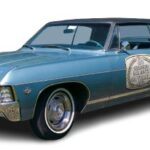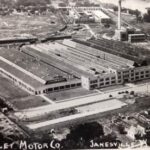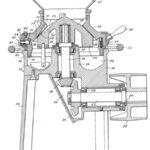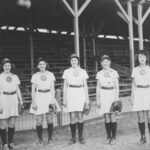Economic tension during the Great Depression in the early 1930s caused a massive shift in labor relations as many workers wanted protection, jobs, and better wages. Many Americans were desperate for jobs that would meet their needs, and this led to grassroot movements including protests where the unemployed demanded jobs at places like auto factories. At the same time workers at these auto factories also began striking, insisting on fair compensation and safer working conditions. These movements forced Congress to act, passing laws such as the 1935 Wagner Act, which strengthened unions by allowing for the formation of trade unions. Originally begun in 1935 under the American Federation of Labor, the United Auto Workers (UAW) officially formed as an independent organization in 1936, and would become a vital tool for auto workers to bargain for rights. In 1937, nationwide strikes helped establish the power of the UAW; these strikes were called sit-down strikes because workers stopped work and sat-down at the plant, remaining in place for many hours or even days.
Before their merger in 1969 and the formation of the united General Motors Assembly Plant, there were two GM outfits in Janesville: the Chevrolet Factory, and Fisher Body Plant; and in the early days of these factories, workers did not have many rights. They were constantly overworked. According to the Fifty Year Book of the UAW, a worker claimed that the floor foreman had told him the secret to getting the most out of workers: work them until they fall over, then work them slightly less next time. The plants were filthy, and another worker complained that he had to buy a second pair of shoes, one for work and one for his house; if he had worn his work shoes at home, they would have damaged the floor. Other workers complained of low pay. The reaction to these conditions culminated in employees at each plant starting local chapters of the national United Auto Workers union. The first rumblings for the Janesville GM plant union began in 1933 when eight employees started holding meetings to discuss unionizing. Eventually, two separate charter unions were started, the Fisher Plant Union was chartered in March, and the Chevrolet Plant Union was chartered in June 1934. The UAW national labor union was formed the following year as a coalition of auto worker unions, and both of the Janesville charters joined that organization. Through their new affiliation the charters became known as Local 95 (Fisher) and Local 121 (Chevrolet). The unions were separate entities, under different leadership, but bonded by the UAW.
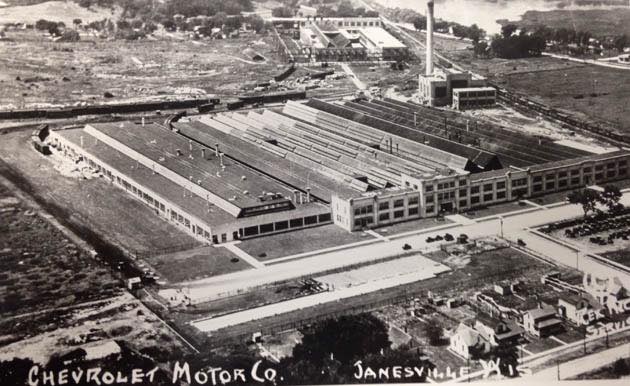
Recognizing that for the UAW to be successful on a national level it would have to establish itself as a national presence, the national president of the UAW, Homer Martin, called for a nation-wide strike in 1937, calling for better working conditions, increased pay, and a contract with General Motors that recognized the bargaining rights of the UAW. While this national protest was primarily focused on the GM plants in Flint, Michigan, chapters around the country, like the Local 95 and 121, joined the movement to demonstrate that the UAW could wield it’s influence nationally. At 1 PM on January 5, 1937, Local 95 President Van Horn told an employee to flip the switch to halt production at the plant, and for the next nine hours, workers participated in a sit-down strike. This method was illegal as it violated the employer’s property rights, but kept workers protected from violence from company goons and prevented scabs from taking their jobs. Workers left the plant around 10 PM after city manager Henry Traxler negotiated the exit of both Chevrolet and Fisher workers from the buildings in a deal with the GM plant to stop production until the strike ended, making it impossible for scab workers to take their jobs. Workers from both Chevrolet and Fisher left the plant together, creating a public spectacle as they all walked out of the main gate of the plant in jubilation. Some strikers soon formed an informal parade with their cars on route to a special meeting at Eagles Hall, honking their horns in excitement. There, union leaders from both plants thanked the striking workers for their commitment. After the meeting another parade of striker’s cars formed with workers shouting and whistling, letting the whole city know they were on strike.
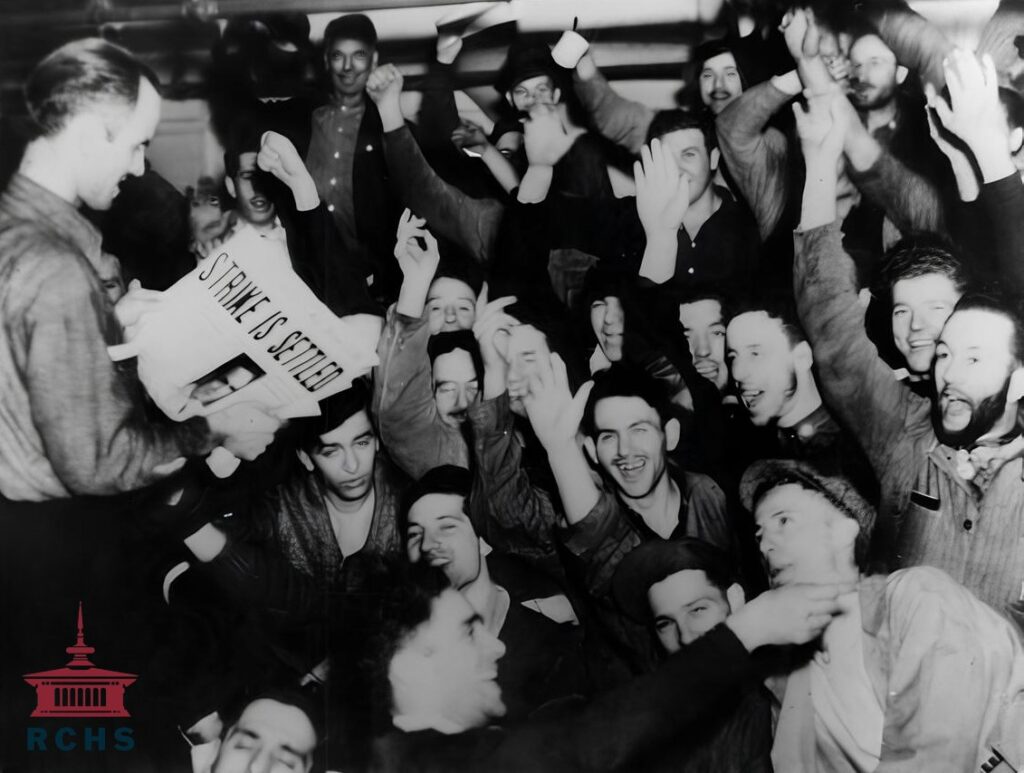
Lasting a little more than a month, the strike kept the plant idle, kept workers unemployed, and had broader implications for the community beyond the plant. Employees working for a company that drove the cars from the factory to other locations were put out of work, as were employees at the Janesville Cotton Mills Company who produced stuffing for car seat cushions. These workers, separate from the plant and the UAW, were eligible to file for unemployment benefits while plant workers, regardless of whether they participated in the strike, were denied these benefits. By early February, the Janesville Gazette reported that local union executives from both charters admitted to leaders of the Local Businessmen’s Committee that there was no way that workers would get back to work in agreement with the local plant. Because the main aim was to obtain a contract that recognized the bargaining rights of the UAW, there was nothing that the heads of the Janesville factories could do to end the strike locally. It would only be after a national contract was settled that the local UAW could deal with issues more specific to the plant (such as working conditions). That contract would come on February 11th, as General Motors and the United Auto Workers union agreed to a deal that gave workers a five-cent raise and recognized the UAW as the bargaining agency for workers in the union, with no discrimination allowed towards workers who went on strike. In return, all workers would return to the plant.
The Janesville GM strike helped raise the national profile of the strikes already happening at plants across the country, establishing the United Auto Workers as a national entity and effectively unionizing the automobile industry. The bargaining power obtained through the UAW impacted the city of Janesville greatly throughout the years, as the union negotiated increased wages and better working conditions after WW2, then organized a strike for better wages after the Chevrolet-Fisher merger in 1969. The union even helped the plant itself in the 80s; after GM moved pickup truck production out of Janesville, the union worked tirelessly to get the rights to produce other vehicles at the plant. Even as late as one year before the Janesville Plant closed, the UAW fought for workers; a strike in 2007 closed 83 General Motors plants including Janesville. This strike was broken with a deal that gave the UAW the power to take care of members health care plans after they retire. Despite the Janesville Assembly Plant closing in 2008, the UAW still cares for their members through their continued health care. The 1937 strike provided a way for workers to bargain for what was fair, leading to decades of success for workers, the GM plant, and the community.
Written by Gabriel Corro, December 2024.
Sources
“City Hall Lobby Crowded For Pay Day of G.M.C.” Janesville Daily Gazette, January 8, 1937.
Mike Dupre, “GM has long, rich history in Janesville.” McClatchy – Tribune Business News; June 3, 2008. https://www.proquest.com/docview/464995523
Chris Isidore, “GM-UAW Reach Deal to End Strike.” CNNMoney, September 26, 2007. https://money.cnn.com/2007/09/26/news/companies/uaw_gm_deal/.
Chris Isidore, “Impact of GM Strike Set to Spread.” CNNMoney, September 25, 2007. https://money.cnn.com/2007/09/25/news/companies/gm_uaw/index.htm
Gillian King, “Anniversary of the 1937 US Sit-down Strike Wave: Remembering Another Occupy Movement.” Links, January 3, 2012. https://links.org.au/anniversary-1937-us-sit-down-strike-wave-remembering-another-occupy-movement
Howard A. Milbrandt, Richard Costerisan, and John O’Meara. Fifty Year Book of the UAW. Beloit, WI: Vance Printing, n.d.
“No Chance of Settling Strike Locally, Business Men’s Committee Is Told,” Janesville Daily Gazette, February 3, 1937.
“Sit-down Makes GM Sit up and Take Notice.” proquest.com, 2008. https://www.proquest.com/docview/456489189
“Sitdown Strike Group Departs After 9 Hours,” Janesville Daily Gazette, January 6, 1937.
“Union to Bargain for Own Members; All Workers Back,” Janesville Daily Gazette, February 11, 1937.

Rock County Historical Society
Research for this object and its related stories was supported by the Rock County Historical Society in Janesville, Wisconsin.
